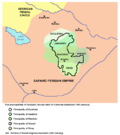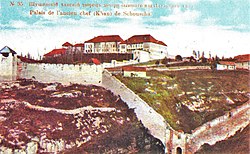Nagorno-Karabakh
Nagorno-Karabakh is a region in the South Caucasus. It is recognized by other countries as part of Azerbaijan, but from 1994 until the 2020 Nagorno-Karabakh war, most of it was militarily controlled by Armenians as the Republic of Artsakh, which was not officially recognized by any other country, including Armenia which supported it.
In September of 2023, Azerbaijan invaded the Artsakh Republic after a long siege. Within a few days, Artsakh surrendered and came under the control of Azerbaijan. Nearly all of Artsakh's population fled to Armenia as refugees.
Demographics
| Year | Armenians | Azerbaijanis[a] | Others | Total | |||
|---|---|---|---|---|---|---|---|
| Number | % | Number | % | Number | % | ||
| 1921[1][2] | 122,426 | 94.73% | 6,550 | 5.07% | 267 | 0.21% | 129,243[b] |
| 1923[3][1] | 149,600 | 94.8% | 7,700 | 4.9% | 500 | 0.3% | 157,800 |
| 1925[3] | 142,470 | 90.28% | 15,261 | 9.67% | 76 | 0.05% | 157,807 |
| Ethnic group | 1926[3][4] | 1939[3][5] | 1959[3][6] | 1970[3][7] | 1979[3][8] | 1989[9] | ||||||
|---|---|---|---|---|---|---|---|---|---|---|---|---|
| Number | % | Number | % | Number | % | Number | % | Number | % | Number | % | |
| Armenians | 111,694 | 89.24 | 132,800 | 88.04 | 110,053 | 84.39 | 121,068 | 80.54 | 123,076 | 75.89 | 145,450 | 76.92 |
| Azerbaijanis[c] | 12,592 | 10.06 | 14,053 | 9.32 | 17,995 | 13.80 | 27,179 | 18.08 | 37,264 | 22.98 | 40,688 | 21.52 |
| Russians | 596 | 0.48 | 3,174 | 2.10 | 1,790 | 1.37 | 1,310 | 0.87 | 1,265 | 0.78 | 1,922 | 1.02 |
| Ukrainians | 35 | 0.03 | 436 | 0.29 | 238 | 0.18 | 193 | 0.13 | 140 | 0.09 | 416 | 0.22 |
| Belarusians | 12 | 0.01 | 11 | 0.01 | 32 | 0.02 | 35 | 0.02 | 37 | 0.02 | 79 | 0.04 |
| Greeks | 68 | 0.05 | 74 | 0.05 | 67 | 0.05 | 33 | 0.02 | 56 | 0.03 | 72 | 0.04 |
| Tatars | 6 | 0.00 | 29 | 0.02 | 36 | 0.03 | 25 | 0.02 | 41 | 0.03 | 64 | 0.03 |
| Georgians | 5 | 0.00 | 25 | 0.02 | 16 | 0.01 | 22 | 0.01 | 17 | 0.01 | 57 | 0.03 |
| Others | 151 | 0.12 | 235 | 0.16 | 179 | 0.14 | 448 | 0.30 | 285 | 0.18 | 337 | 0.18 |
| Total | 125,159 | 100.00 | 150,837 | 100.00 | 130,406 | 100.00 | 150,313 | 100.00 | 162,181 | 100.00 | 189,085 | 100.00 |
Etymology
The names for the region in the different local languages all translate to "mountainous Karabakh", or "mountainous black garden". The word "nagorno" is Russian for "mountainous/on the mountain", "kara" is Turkish for "black", and "bakh" means "garden" in Azerbaijani.
- Armenian: Լեռնային Ղարաբաղ, transliterated Lernayin Gharabagh
- Azerbaijani: Dağlıq Qarabağ, or Yuxarı Qarabağ (meaning "upper Karabakh" or "mountainous Karabakh")
- Russian: Нагорный Карабах, transliterated Nagornyj Karabakh
History
Around 180 BC, Artsakh became one of the 15 provinces of the Armenian Kingdom and remained so until the 4th century.[10] Then it became part of the Sasanian Empire. In the 7th century, the region was conquered by the invading Muslim Arabs. The House of Khachen, then ruled Artsakh until the early 19th century.[11] Persia formally ceded the whole of Karabakh to the Russian Empire by the Treaty of Gulistan in 1813. In April 1920 Azerbaijan was taken over by the Bolsheviks. It was in the Azerbaijan Soviet Socialist Republic. In the 1980s there was a movement to have the autonomous oblast transferred to the Armenian SSR.[12] When Mikhail Gorbachev came to power in Moscow and started campaigns of publicity and democratic reforms at the end of the 20th century, Armenians living in Nagorno-Karabakh sent letters to Gorbachev demanding him to move the autonomous oblast to the control of Armenia. When it was declined, the Armenians started an independence movement.
In November 1991, seeking to stop this movement, the Parliament of Azerbaijan abolished the autonomous status of the region. In response, the Nagorno-Karabakh Armenians held a referendum on December 10, 1991, which was boycotted by Azerbaijanis living in Nagorno-Karabakh and none of them participated in it, therefore the overwhelming majority of the population voted for independence.
Gallery
The Gandzasar monastery, built in the 1200s
Nagorno-Karabakh Media
June 2001 NASA photograph of the snow-covered Lesser Caucasus to the south of the Greater Caucasus. Around the year 1800, the Karabakh Khanate was based in the southeast corner of the Lesser Caucasus. It extended east into the lowlands, hence the name Nagorno- or "Highland-" Karabakh for the western part.
The Amaras Monastery, founded in the 4th century by St Gregory the Illuminator. In the 5th century, Mesrop Mashtots, inventor of the Armenian alphabet, established at Amaras the first school to use his script.
The monastery at Gandzasar was commissioned by the House of Khachen and completed in 1238
The Shusha fortress, built by the Karabakh Khanate ruler Panah Ali Khan in the 18th century
Aftermath of the Shusha massacre: Armenian half of Shusha destroyed by Azerbaijani armed forces in 1920, with the defiled Armenian Cathedral of the Holy Savior in the background.
A restored Armenian T-72, knocked out of commission while attacking Azeri positions in Askeran District, serves as a war memorial on the outskirts of Stepanakert.
References
- ↑ Until 1936, Azerbaijanis were known as "Tatars" or "Turkish-Tatars".
- ↑ With the city of Shusha included, the NKAO's total population was 138,466, the adjusted ethnic composition is as follows:
- Armenians – 122,715 (88.62%)
- Azerbaijanis – 15,444 (11.15%)
- Others – 307 (0.22%)
- ↑ Until 1936, Azerbaijanis were known as "Tatars" or "Turkish-Tatars".
Other websites
- Karabakh documents Archived 2006-12-08 at the Wayback Machine
- Artsakh from ancient time till 1918 Archived 2009-08-04 at the Wayback Machine
- Artsakh (Nagorno Karabakh) - France 24 Report
- ↑ 1.0 1.1 Cory D., Welt (2004). Explaining ethnic conflict in the South Caucasus: Mountainous Karabagh, Abkhazia, and South Ossetia (PDF). Massachusetts Institute of Technology. p. 116. OCLC 59823134. Archived (PDF) from the original on 11 September 2022.
- ↑ "Перепись населения АзССР в 1921 г." [Census of the population of the AzSSR in 1921]. karabagh.am. Archived from the original on 26 May 2011. Retrieved 26 June 2022.
- ↑ 3.0 3.1 3.2 3.3 3.4 3.5 3.6 Beglaryan, Ashot. "The population of Nagorno-Karabakh for a year. Union of Armenians of Russia - Nagorno-Karabakh Republic. Excursion into history". losevskaya.ru. Stepanakert. Archived from the original on 31 October 2022. Retrieved 31 October 2022.
- ↑ Всесоюзная перепись населения 1926 года. Национальный состав населения по регионам республик СССР Archived 5 June 2016 at the Wayback Machine Демоскоп
- ↑ Всесоюзная перепись населения 1939 года. Распределение городского и сельского населения областей союзных республик по национальности и полу Archived 5 June 2016 at the Wayback Machine Демоскоп
- ↑ Всесоюзная перепись населения 1959 года. Городское и сельское население областей республик СССР (кроме РСФСР) по полу и национальности Archived 5 June 2016 at the Wayback Machine Демоскоп
- ↑ Всесоюзная перепись населения 1970 года. Городское и сельское население областей республик СССР (кроме РСФСР) по полу и национальности Archived 5 June 2016 at the Wayback Machine Демоскоп
- ↑ Всесоюзная перепись населения 1979 года. Городское и сельское население областей республик СССР (кроме РСФСР) по полу и национальности Archived 5 June 2016 at the Wayback Machine Демоскоп
- ↑ Всесоюзная перепись населения 1989 года.Распределение городского и сельского населения областей республик СССР по полу и национальности Archived 5 June 2016 at the Wayback Machine Демоскоп
- ↑ Hewsen, Robert H. "The Kingdom of Artsakh", in T. Samuelian & M. Stone, eds. Medieval Armenian Culture. Chico, CA, 1983.
- ↑ Robert H. Hewsen, Armenia: A Historical Atlas. The University of Chicago Press, 2001, pp. 119, 155, 163, 264–65.
- ↑ Audrey L. Altstadt. The Azerbaijani Turks: power and identity under Russian rule. Hoover Press, 1992. ISBN 0817991824, 9780817991821















